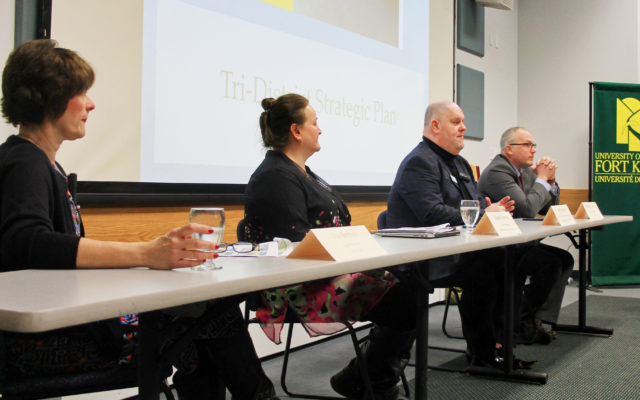
ST. JOHN VALLEY, Maine — By August, a collaborative of St. John Valley school districts could very well be formulating plans for a new unified high school that the state will fund.
Maine School Administrative Districts 27 and 33 in the Fort Kent and Frenchville areas, the Madawaska School Department, and the St. John Valley Technology Center, currently known together as the Valley Unified Regional Service Center, have been working together since last year to win state funding.
- Madawaska School Superintendent Gisele Dionne delivers the St. John Valley education collaborative’s final application for an Integrated, Consolidated 9–16 Educational Facility to the Maine Department of Education’s Facilities Director Scott Brown on Dec. 29, 2017. The Board of Education revealed on June 13 that the Valley project has the top score among the three finalists. (Contributed photo)
The state is offering up to $100 million to the regional winner of the Maine Department of Education’s Major Capital School Construction Pilot for an Integrated, Consolidated 9-16 Educational Facility.
The intent of the competition is to encourage neighboring school districts with declining enrollments and rising expenses to work together to combine resources and save costs. The preferred project, according to the state, would combine three or more high schools to create a new regional high school integrated with a career and technical education school and with the University of Maine System and the Maine Community College System.
Seven regional groups from around Maine initially applied for consideration for the pilot school program. Only three were invited to continue on to the second and final phase of the application process, including the Valley Regional Service Center; a Southern Aroostook area collaborative out of the Houlton (RSU 29), Hodgdon (SAD 70), Danforth (SAD 14) and Dyer Brook (RSU 50) areas, and the Region Two School of Applied Technology; and an effort that includes SAD 46 (Dexter area), SAD 4 (Guilford area), SAD 41 (Milo area) RSU 82/MSAD 12 in the Jackman area, the Greenville School District, and the Dexter-based Tri-County Technical Center.
The second phase involved a priority list that ranked the three finalists on a point system to determine which proposal satisfied the most criteria.
The St. John Valley initiative scored highest in that second phase in February, but SAD 46 officials filed an appeal of the findings on March 12, forcing the state commissioner of education to rescore the applications.
- Local education leaders share their thoughts on regionalization during a business breakfast at the University of Maine at Fort Kent on Dec. 8, 2017. Participating in the event are, from left, SAD 33 Superintendent Lisa Bernier, Madawaska Superintendent Gisele Dionne, consultant Scott Voisine and SAD 27 Superintendent Ben Sirois. (Staff photo/Don Eno)
On June 13, the Maine State Board of Education announced the revised results, and the Valley Regional Service Center remained on top.
Each of the collaboratives has 30 days to appeal the latest results.
SAD 46 Superintendent Kevin Jordan said Friday that he had heard about the new ratings but “not officially been notified from the Department of Education. I am expecting a letter any day now.
“I have heard nothing as far as where it goes from here,” he said, though he anticipated having 30 days to appeal.
Barring any appeal, things are looking good for the Valley Unified Regional Service Center, according to SAD 27 Superintendent Ben Sirois.
“If there are no appeals of this revised priority list, the commissioner of education will recommend the list to the state board as a final step in the process. That means, we will stay first place and our region will be awarded the school,” Sirois said Thursday.
The superintendent said that if the St. John Valley proposal is selected for the pilot project, grant money from the state would cover the cost of a new high school, with no local funding being needed.
Among the next steps, the winners would have to pick a location for the new school and obtain local voter approval for the collaborative project.
“Once the site has been selected and approved by the state, the final step is voter approval from the member communities,” Sirois said.
The superintendent has been a proponent of the regional high school effort from the start, and said he hopes voters will feel the same.
“I feel this opportunity will never come around again, so how our region handles this gift will define the future of St. John Valley education. We have been able to produce quality education for years as separate school districts, but with enrollments dropping and state funding decreasing, business as usual will no longer be sustainable,” he said. “We need to have future ready schools to prepare our students for their future, we need to be proactive in our approach, and if granted the regional high school, we need to accept this gift with arms wide open.”
Gov. Paul LePage also supports the regional high school initiative.
“Communities across Maine are demonstrating that when the state provides them with support and incentives, they will work together to create more opportunities for students in an efficient and effective way,” LePage said in a February press release. “I commend the local superintendents and school boards for putting the needs of their students first.”









